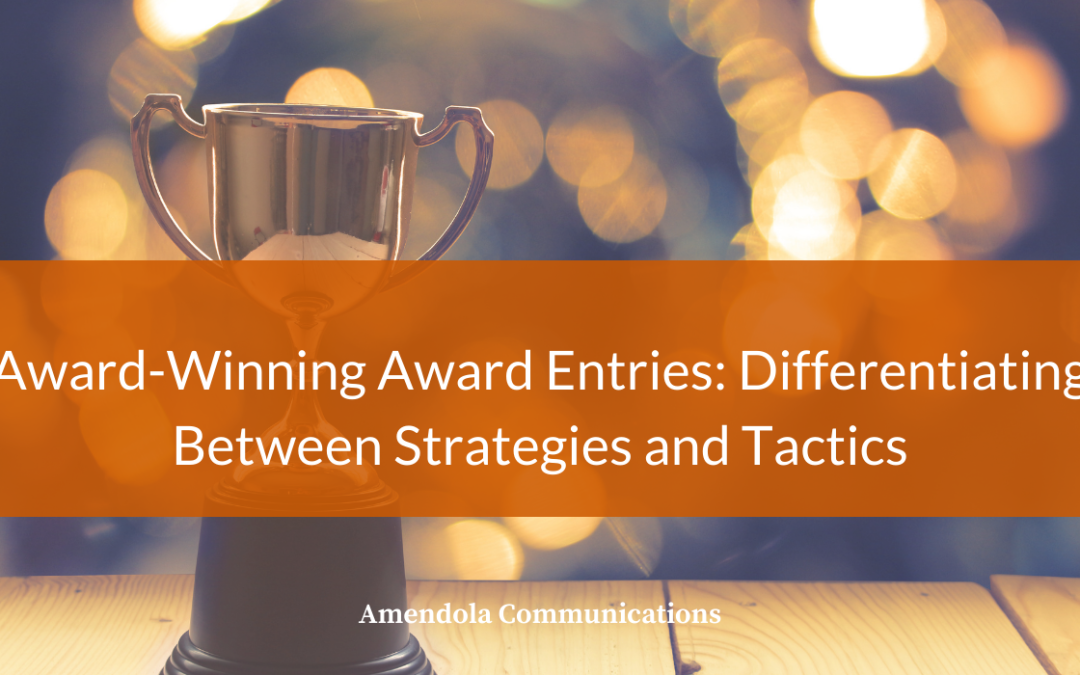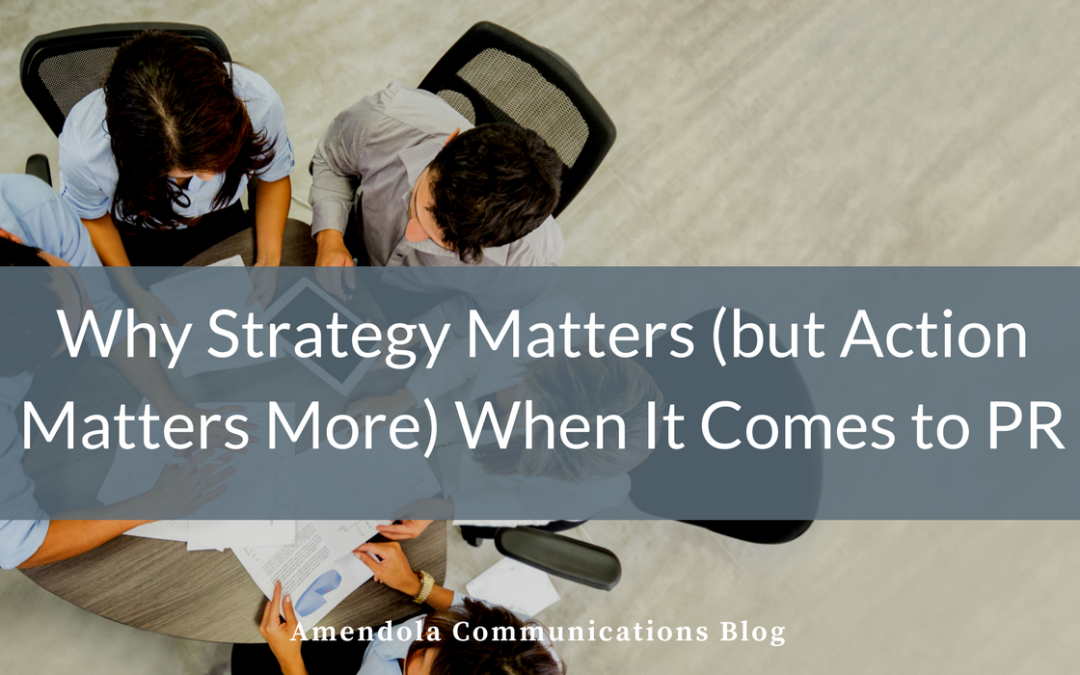
AI is NOT a Healthcare PR Strategy
What does our very own Grace Vinton say about AI?
“AI is not a healthcare PR strategy.”
But Grace also shares where she believes AI can fit in.
Check out what she has to say in this VLOG!

What does our very own Grace Vinton say about AI?
“AI is not a healthcare PR strategy.”
But Grace also shares where she believes AI can fit in.
Check out what she has to say in this VLOG!

My colleague Philip Anast recently shared some advice from the Wall Street Journal via the Advisory Board regarding situations “where it’s better to slow down at work.”
Let’s be honest: In the hyper-paced world of healthcare public relations and marketing, where there’s a product rollout, speaker submission, or awards deadline around every corner, the notion of “slowing down at work” is downright antithetical. When you’re managing multiple accounts – and trying to make each feel as if they are your highest priority – you instinctively fear that slowing things down will derail your strategic timelines, frustrate your clients, and send your blood pressure soaring. Why make an already intense job even more stressful?
The answer is there are times in PR and marketing where slowing down is essential to doing the best job for your clients, your agency, and your sanity. Here are three situations when slowing down pays off in PR and marketing. These apply to in-house marketing/PR pros, who face pressures similar to those of agency workers.
When you’re the final set of eyes
Marketing and PR pros must create and process high-level, detailed content every day. Thought-leadership bylines, case studies, white papers, press releases, sales sheets, analyst pitches – it never ends. If your client is a life sciences company, you may be writing about concepts that may be ever-so-slightly outside your wheelhouse. That’s OK – you probably didn’t go to medical school, and your yearslong devotion to Grey’s Anatomy will only get you so far.
Still, when you’re delivering content assets, it’s important to get everything right. And no matter how many people look at the “final” draft of a byline, press release, or other public-facing deliverable, someone will be the last set of eyes before the news release is sent to Cision or the byline to your client’s CEO.
Even if it’s the 10th time you’ve read it, do so with intense focus just one more time. Read slowly, scan for typos, and pay attention to flow and impact. This is your last chance! Put another way, if there’s something wrong that you didn’t catch, you may be catching flak from the client, who is paying the agency good money to not mess up content.
When your client wants to do something impulsive and perhaps ill-advised
Clients can be quite emotional. Which is understandable. They’re under pressure on multiple fronts from competitors and investors. They are responsible for executing on product, market, and growth strategies. They’re probably working 70 hours a week. Plus their chief marketing officer just abandoned the company for a new job. And their kids have the flu.
Nonetheless, when the client’s CEO decides what the company needs to do is issue a press release every day for a week before HLTH to carpet-bomb the market into recognizing the pioneering brilliance of their platform (something I heard an investor for a startup insist on), you must slow their roll. Politely but firmly explain how a press release a day doesn’t really align with the rhythm of how the healthcare tech media operates – “Company X made a big splash today. I can’t wait to see what they’ve cooked up for tomorrow!” said no tech reporter, ever – and that it also would be a waste of money. (The money message eventually got through to the investor.)
Similarly, if a CEO wants to confront that editor from Healthcare IT News who omitted the company from a roundup of startups to watch in Sector Z in the coming year and clearly harbors a grudge against us, you must counsel restraint. Emphasize the importance of cultivating long-term relationships with the media, analysts, and others in the industry ecosystem who could help the company down the road. Just giving your excitable clients some time to vent often is enough to defuse a mini-crisis.
When there’s a full-blown PR crisis
Sometimes an actual crisis will arise – your client’s product is the subject of a recall or warning, a customer files a major lawsuit, an investigative article in the mainstream media that mentions the company in a negative light blows up on social media, etc. You’ve got to move fast or things will quickly spin out of control!
Making a public statement that can be easily contradicted, however, will only worsen the problem. Thus, it is imperative that you know the facts. Make sure you take the time to gather all the facts surrounding the issue and are interpreting them correctly. You only have one chance to respond the first time to a crisis. Make it count.
Conclusion
In the PR and marketing biz, you need to think fast and move fast. Sometimes, though, slower is better.
So, you want to engage a PR agency to help get the word out about your solutions or services.
Sounds like a plan. Sounds easy.
But the process can be daunting, time-consuming, and expensive. And, most importantly, it may not help you achieve your goals.
If this sounds oddly pessimistic coming from someone in an agency, bear with me. I’m here to share some considerations, observations, and best practices gleaned from over three decades split between agency and corporate marketing gigs. Avoiding the mistakes of others can save you time and money, and result in a productive, positive working relationship with your agency.
Know what you want to accomplish.
Do you need straight-up media relations? Industry analyst engagement? Help with messaging and positioning? Social media strategy and support? Editorial and content development? Speaking opportunities? Is there the potential for crisis management? Will your executives require media training?
Having a grasp of your near- and longer-term objectives can help you narrow the field. Most agencies will claim to provide a full menu of such services, but the quality and scope of the offerings can vary wildly. Be skeptical and do your due diligence.
PR Agency? Full-Time Employee? Freelancer?
There are pros and cons to each of these approaches, and your organization’s budget, timeline, and internal processes will dictate the best approach.
Agencies can be expensive, depending on the retainer structure or the billable rates of your account team, but can actually be more cost-effective than the alternatives. They also bring a wealth of expansive and deep marketing expertise, along with a solid bench. They are often very good at helping determine what you need (see above), are responsive and reliable, and 100% dedicated to your agenda. Agencies also provide access to a host of services––from art/creative direction and design, to web development, digital marketing, and social media strategy and support.
Full-time employees are great because they are invested in your success and are in it for the long haul. But they often require substantial budget outlays, and can take months to identify, recruit, sign, and onboard. Once they are thoroughly steeped in your offerings, they can be outstanding brand ambassadors and stewards, and can also work on other marketing initiatives as needed. But once they leave, you’re back to square one.
Freelancers can be nimble hires––they often have excellent credentials, can start right away, and hit the ground running. But they typically operate with minimal resources, have no back-up, and must dedicate hours to other clients. They also can be brutally hard to integrate into existing systems (HR/accounting, project management, content management). They also are prone to terminating their arrangements abruptly (which can also work in your favor if you only need a limited engagement).
One size does not fit all.
Yes, big agencies have big resources, but don’t let claims of a national footprint, local presence, global reach, or head count sell you on an ill-matched relationship. Think expertise, applied experience in your market, and skillsets that dovetail with your agenda. Access to creative resources is a plus. Know how many hours are available to your account each week or month.
Who’s on the team?
This consideration also hinges on knowing what you want to accomplish. If you’re looking for a clip shop to get you mentioned in every low-value round-up article, then seniority matters little. But if you’ll need responsive counsel with expertise in and contacts spanning your market, look for senior-level account team members. Ask the tough questions: What’s the average tenure of your account team? Where have they worked? What companies have they represented? What results have they generated? How many former journalists are on staff? How many accounts do they manage at once?
Mind the old switch-a-roo.
Let’s assume you’re down to a few final candidates and are evaluating pitches. For these meetings, most agencies will send out the big guns––often including the person with his/her name on the door. But will you ever see or hear from these folks again? Many times, agencies get a bad rap by orchestrating a senior executive dog-and-pony show, only to later hand the account over to junior staffers (or even interns) who, while eager, often require more direction and a longer ramp-up period. Get firm commitments on your team’s composition, and don’t hesitate to challenge if you aren’t sold on the match. You want them to operate as an extension of your team.
Beware of scope creep.
Will the agencies you are considering be able to accommodate your needs as your marketing strategy evolves? If your program may eventually require social media support, make sure the agency of record has the capabilities––and not just an intern with a huge stable of Instagram followers, but applied expertise in cultivating an online presence with a custom mix of organic and paid content. Ditto for the media training and crisis communications mentioned earlier. Otherwise, you’ll be saddled with the chore of evaluating and enlisting additional vendors.
In the end, it’s entirely up to you, and highly dependent on your organization’s budget, processes, and requirements. And remember, the old adage, “Fast, cheap, or good? You can only pick two” applies here as well. If you want something fast and good, it won’t be cheap; if you want it cheap and good, it won’t be fast; and if you want cheap and fast, it won’t be good. Choose wisely.

Whenever I get award entries (or PR proposals for that matter) to review, I am always struck at how much confusion there is between what constitutes a strategy versus a tactic.
Generally what I will find is that the strategies and tactics are mixed together in some sort of strange PR stew that is like covering seasoned beef with strawberry jam. Both are tasty on their own, but together they just don’t quite work.
This confusion becomes more evident on entry forms that ask for deeper details. If all the competition is asking for is some company details and 300-word description of why whatever you did is award-worthy you don’t have to spend a lot of time separating strategy and tactics.
If, however, the entry form asks for 500 words on strategies around the objectives, then another 500 words on the tactics/execution you used to achieve the objectives, well, you’re going to need to understand the difference. Or find someone who does. Or hope the judges don’t understand it any better than you do.
Basically, the strategy is the overall plan of action – the big picture of what you intend to do. The tactics are the actions you take to get it done.
In baseball, for example, the strategy in a close game might be to advance a runner on first into scoring position (i.e., second or third base for those not familiar with baseball lingo). Doing so will give you a heightened opportunity to add a run to your total (at least in theory; SABRmetrics has shattered a lot of those beliefs in recent years).
HOW you advance that runner is where the tactics come in. You could lay down a sacrifice bunt. You could have the hitter try to bunt for a hit. You could do a hit-and-run, where the runner on first takes off for second and the hitter tries to hit the ball behind him to the right side. You could have the runner on first steal second while the hitter covers him with a swing and miss.
All of those are valid tactics or ways of getting the runner to second. Which you use depends on your personnel and a whole bunch of other factors.
Now let’s talk about PR award entries and why it seems so difficult to tell the two apart. Let’s say one objective of the program is:
“Company A was losing sales to larger competitors, so it needed to create a larger-than-life image to overcome this hurdle.”
How did they plan to do that? The strategy was to use PR to increase its visibility in the marketplace without the huge investment advertising would require. But here’s where it starts to go wrong.
The next sentence in the “strategy” section will talk about how Company A started issuing press releases and thought leadership pieces on a regular basis.
No, those are tactics. They required specific actions from Company A or its agency. The same is true with launching a media relations or analyst relations program. Those, again, are actions the company took.
Again, strategy defines what needs to be done on a broad scale – in other words a business issue. Tactics describe the steps you will take/are taking/have taken to accomplish the strategy.
Here are a few more quick examples that will help stratify the three areas – goals/objectives, strategy and tactics – in your award entries and other materials:
Goals/Objectives
Strategies
Tactics
The beauty of understanding the differences is that award entries then practically write themselves. They tell the story of how you started broadly, then worked your way through the process to achieve the results.
Taking that little bit of extra time to think through what is a strategy versus a tactic isn’t always easy. But it’s worth the effort – especially when you receive that happy notification that you’ve won the award you were targeting.

We’ve all heard of analysis paralysis the state of over-analyzing or over-thinking a situation so much that a decision is never made and the outcome is impacted. Recently I’ve been witnessing a curious yet similar phenomenon at healthcare IT companies across the country and the analysis paralysis is all about “strategy.” As in overall corporate strategy and direction.
In short, these companies are all about strategic planning, but in the end they seem to come out of it having virtually no strategic plans. They’re all about all-day strategy meetings which result in no strategy but rather more questions that prompt more all-day meetings and shockingly, yet still no strategy.
From the outside looking in, this cycle is an endless hamster wheel that leaves team members feeling tired rather than energized, frustrated rather than empowered, and most troublingly, so terrified that their actions won’t follow the still-to-be-approved (or never-to-be-approved) strategy that they simply don’t act. This inaction can be minor or major as it builds up over time but it’s always detrimental.
Back to basics to get results
Their “strategic focus,” while well-intentioned, sets companies on the wrong path in the short and long-term, especially in regards to PR which should have a constant, ongoing cadence to create momentum and maximize results.
While company strategies can be complicated and have a profound impact on PR efforts, many aspects of PR strategy are quite uncomplicated. In fact, there are core tenets which are quite basic and fundamental to any sound PR plan. There are the pillars that cannot be disputed so they need not be delayed regardless of executive indecision.
Whether your strategy is set or you’re one of many stuck on the endless hamster wheel, these four actions are key to success. They are mission-critical, and safely fit into any PR strategy for 2018 and beyond:
1. Write and distribute press releases
It sounds like a no-brainer but for many companies it’s not because they live in fear of being “off brand” or “misaligned.” They live in fear of putting out too many press releases yet not enough press releases. Those fears are unwarranted though since your company is doing good work. Why shouldn’t it be shared? Did you develop a new product? Let’s write a release. Did you sign a new customer? Let’s write a release. Is your CEO speaking at an industry event? Let’s write a release.
Writing a press release is one of the simplest ways to communicate what’s happening and why it matters. Distributing those press releases positions your company as a key player and thought leader in the ongoing industry dialogue. It’s not complicated. It doesn’t need to be debated and as long as you’re not regularly putting out more than 2-4 press releases per month, you’re not overdoing it. So, just do it.
2. Highlight your customer’s success stories
Once again, it sounds like a no-brainer. You have customers. They like your products. They like your team. They have achieved impressive results that they’re willing to share. Let them be your advocates. Capture their stories in writing. Put them in front of reporters who are eager to hear from both executives and end-users at provider organizations. It’s as simple as that. Just like with press releases, these customer success stories illustrate that your company is doing good work and that’s what makes more customers want to work with you, which of course is one of the biggest end goals of any strategy. It’s not complicated. It doesn’t need to be debated. As long as your customers are singing your praises, hand over the microphone and let them sing.
3. Emphasize your expertise
In addition to highlighting your clients, highlight your company’s thought leaders. After all, they are also doing good work (you may see a pattern here). They have knowledge to share. They have ideas to contribute. They are the faces of your company and you need some faces even if you don’t have a final strategy. This action can mean authoring bylined articles or blogs on their behalf or pitching them as experts for media interviews. By positioning your executives and SMEs as thought leaders and joining the industry conversation, you’re helping to make your company a go-to source for future media opportunities. It’s not complicated. It doesn’t need to be debated and it would really be a shame for their knowledge to go to waste.
4. Educate your sales team about PR efforts
Regardless of strategy indecision, your sales team needs to close deals. There is nothing off-strategy about building your business. Media placements from your PR efforts are one of the most powerful but underutilized tools in your sales team toolkits. Obviously, sales prospects are not interested in the same information as the media. In fact, they may be turned off by being sent a press release about a new client that just signed on. However, they may be very interested in press coverage from well-regarded industry publications that profile your company news, thought leadership, and customer success stories. That is not only informative but also adds credibility and implies that you want to keep them in the know.
Similarly, if one of your client case studies is featured in a third-party publication, that’s a prime opportunity to reach out, share the article and offer a reference call with the client quoted. It’s not complicated. It doesn’t need to be debated and if you’re earning media placements it is certainly a shame not to use them to their fullest potential.
It’s time to get off the hamster wheel and get on with the real work that makes a difference.